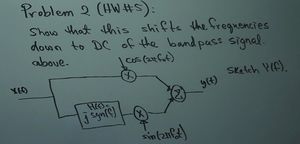Signals and Systems: Difference between revisions
Jump to navigation
Jump to search
| Line 27: | Line 27: | ||
===Dirac Delta Function and Convolution=== |
===Dirac Delta Function and Convolution=== |
||
*[http://web.mit.edu/2.14/www/Handouts/Convolution.pdf MIT handout on Dirac Delta Function and Convolution] |
*[http://web.mit.edu/2.14/www/Handouts/Convolution.pdf MIT handout on Dirac Delta Function and Convolution] |
||
===Multi-rate Filtering=== |
|||
[http://www.google.com/url?url=http://www.mds.com/tech/filter/multirate_article.pdf&rct=j&sa=U&ei=pD_UTJqtKY6ksQPbzPWMCw&ved=0CBUQFjAA&q=Purcell+Multirate+Filters&usg=AFQjCNFsHM7ROpUdrQ6py9ZH_RhQ_BeigA Multirate Filters Introduction] |
|||
===Course Pages=== |
===Course Pages=== |
||
Revision as of 09:34, 5 November 2010
Topics
Overview of Signals and Systems
Individual Subjects
- Linear Time Invariant Systems
- Orthogonal Functions
- Finding the Energy in a Signal
- Fourier Series
- Fourier Transforms
- Sampling
- FIR Filter Example
- Relationship between e, sin and cos
Some Useful Links to Suppliment or Substitute for a Textbook
Books on Signal Processing
Fourier Series
- Interactive Mathematics (like a textbook with some examples)
- Mathworld
- Wikipedia
- MIT handout on Fourier Series, Fourier Transform, and Laplace Transform
- Fourier Theory B..M..N.. Clarke
Dirac Delta Function and Convolution
Multi-rate Filtering
Multirate Filters Introduction
Course Pages
Class notes for Signals & Systems
Articles
Octave Tutorials
Installing Octave on a Mac (Chris Lau)
Octave and Scilab on a Mac (Ben Henry)
ASN2 - Octave Tutorial (Jodi S. Hodge)
Table of Fourier Transform Properties
Homework Assignments
Please put your name next to the assignment, linking it to your submission
- HW #1 - Make a personal page on this wiki (Chris Lau)(Jodi S. Hodge)(Chris Wills)
- HW #2 - Write a tutorial about installing and/or using Octave (Chris Lau)(Jodi S. Hodge)(Victor Shepherd)
- HW #3 - Show graphically that (Chris Lau)(Jodi S. Hodge)(Chris Wills)(Victor Shepherd)
- HW #4 - Given a linear time-invariant system where produces an output , find the output due to any function (Chris Lau)
- HW #5: (Chris Lau)
- Part 1 - Find and relate it to the Laplace Transform. Derive the Inverse Laplace Transform of this from the inverse Fourier Transform.
- Part 2 -
- HW #6 - Pick a property of the Fourier Transform & present it on the Wiki. Make a table with all your properties. Interpret your property. (Ben Henry)(Chris Lau)
- HW #7 - Finish the practice tests
- HW #8 - Make a page about interpolating FIR filters. Note how many multiply/add operations.




![{\displaystyle {\mathcal {F}}[e^{-\sigma t}x(t)u(t)]}](https://wikimedia.org/api/rest_v1/media/math/render/svg/fff13c3c7a479f107c9e90e0aed1908dd4a969ce)
